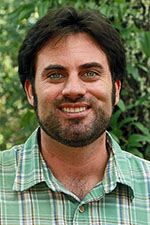Originally prresented 14 Jan 2012
Polar oceans seem like a difficult place to make a living. Yet they are the home to many very large animals, such as seals, whales, and polar bears. Part of the explanation for how these large animals can survive in such a seemingly harsh environment ultimately goes back to the microbiology of sea ice. Did you know that there is an entire complex community of plants and animals that are specialized to live inside sea ice? Find out more from research biologists Andrew Juhl and Craig Aumack.


Introduction to this Workshop
“The Life Inside Sea Ice” slideshow pptx pdf
Cutting-Edge Research
Andy Juhl’s research and teaching focus on how aquatic microorganisms and their predators interact with each other and their physical/chemical environment. His work finds application in understanding geochemical fluxes, harmful algal blooms, water quality, and sea ice ecology.
Craig Aumack comes to LDEO as a Postdoctorate Research Fellow, working with Andy to study polar algae and their role in ecosystems.
Questions that Andy’s team are investigating include:
What factors control the growth of algae inside of sea ice?
How is the community of organisms inside sea ice connected to other arctic marine organisms?
What is the fate of organic matter that builds up inside sea ice?
Here are links to Andy’s E2C presentation and some related news stories:
Website: http://www.ldeo.columbia.edu/~andyjuhl/Welcome.html
“Researchers Crack the Ice to Study Arctic Marine Food Web”
“Studying Arctic’s Ice and Snow to Track Climate Change”
“Sea Algae Is Staple of Arctic Food Chain”

Classroom Resources
American Museum of Natural History Science Bulletins
Of special interest: Sea Ice
ARISE (ANDRILL Research Immersion in Science Education)
Online classroom activities developed in conjunction with the Environmental Literacy Framework (ELF), with a focus on climate change.
Teachers Experiencing the Arctic and Antarctic (TEA)
This project ended in 2005, but provided many useful activities created during the TEA Transfer Workshop at the American Museum of Natural History in 2003.
Of special interest to this E2C session is:
“Cold, Hard Facts” by Tina King and Bob King
Students will work with “ice” to gain practical application of math concepts that evolve into an inquiry-based study to determine if dimensions of ice make a difference in the way ice floats in water.
Windows to the Universe: Arctic Marine Life
Make an Arctic Food Chain Mobile
Gulf of Marine Aquarium Antarctica Activities
Classroom activities created in conjunction with NASA’s Learning from satellites.
Of special interest: Creating Plankton
Other Resources for This Topic
National Snow and Ice Data Center (NSIDC): All About Sea Ice
Of special interest: Phytoplankton
NASA Earth Observatory: Life in Icy Waters
Alfred Wegener Institute: Sea Ice–An Antarctic Habitat
‘Dirty Ice in the Chukchi Sea’–Ecology Picture of the Week from Dr. Bruce C. Marcot
Brasileiros inauguram módulo científico no interior da Antártida
Integrating Educational Technologies
General suggestions: Integrating Educational Technologies into Your Classrooms
Your assignment: Using Movies Effectively in the Classroom
1) What characteristics make a feature movie effective as a classroom teaching tool?
2) When should feature movies be used for full-class instruction, and when should they be used for small groups or individual projects?
3) Describe strategies to locate suitable feature movies for your classes.
and
4) Design a lesson plan that incorporates at least one feature movie.
Through the ESPRIT list-serv, Cheska Lorena suggested a link to online lesson plans, using “October Sky” as an example: http://moviesheets.com/site/sheets.php?id=178
E2C Follow-up:
You may send your model lesson and other responses to this “assignment” to michael@earth2class.org. If suitable, we will post your work in the E2C lesson plans and/or add them to this section of the Workshop website.
Multimedia
Link to Andy Juhl’s “Life In and Under Arctic Sea Ice” video:
http://www.ldeo.columbia.edu/~andyjuhl/Life_in_Sea_Ice.html


